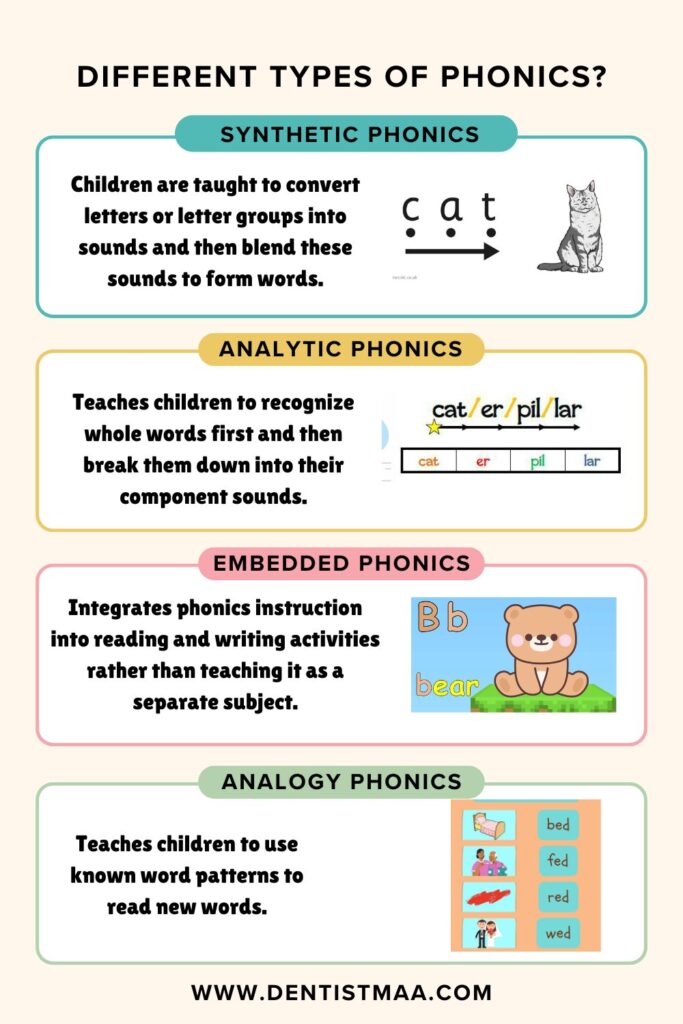Phonics is a term that has become increasingly popular in early childhood education. Parents and educators alike are recognizing its value in helping children develop essential reading skills. But what exactly is phonics, and why is it so important for your child’s development? This blog post will explore these questions in detail, providing a comprehensive understanding of phonics, its role in literacy, and how it can benefit your child.
What is Phonics?
It is a method of teaching reading by connecting the sounds of spoken language with letters or groups of letters in written language. It is based on the understanding that words are made up of sounds (phonemes) and that these sounds can be mapped onto written symbols (graphemes). For example, the word “cat” consists of three sounds: /k/, /æ/, and /t/. In phonics, children are taught to recognize these sounds and connect them to the corresponding letters C, A, and T.
IT is often contrasted with the “whole language” approach, which emphasizes the recognition of entire words rather than focusing on individual sounds. It provides a solid foundation for decoding new words, making it an essential tool in the early stages of reading instruction.
The Basics of Phonics Instruction
The instruction typically begins in kindergarten and continues through the early elementary grades. It is often broken down into several key components:
- Phonemic Awareness: This involves the ability to hear, identify, and manipulate individual sounds (phonemes) in spoken words. For example, a child might be asked to identify the first sound in the word “dog” (/d/).
- Alphabetic Principle: Children learn that there is a systematic relationship between letters and sounds. They are taught that letters represent sounds and that these sounds can be blended to form words.
- Decoding: This is the process of sounding out words by recognizing the individual sounds that make up the word. For example, a child would decode the word “mat” by recognizing the sounds /m/, /æ/, and /t/ and then blending them together.
- Blending: Blending involves combining individual sounds to form words. For example, the sounds /s/, /u/, and /n/ can be blended to form the word “sun.”
- Segmenting: This is the reverse of blending. Children are taught to break words down into their individual sounds. For example, the word “fish” can be segmented into the sounds /f/, /ɪ/, and /sh/.
- Sight Words: While phonics focuses on decoding, some words do not follow regular phonetic patterns. These are known as sight words, and children are often taught to recognize them by sight (e.g., “the,” “said,” “come”).
Why is Teaching Phonics Important?
It is a crucial component of early literacy development for several reasons:
- Building a Strong Foundation for Reading
It provides children with the tools they need to decode new words, which is essential for independent reading. By understanding the relationship between letters and sounds, children can sound out unfamiliar words, leading to improved reading fluency and confidence. This foundational skill is critical for future academic success, as reading is the gateway to learning in all subject areas.
- Enhancing Spelling Skills
Phonics instruction not only improves reading skills but also enhances spelling. By understanding the relationship between sounds and letters, children are better equipped to spell words correctly. For example, a child who knows that the sound /k/ can be represented by the letters “c,” “k,” or “ck” will be able to spell words like “cat,” “kite,” and “duck” more accurately.
- Supporting Language Development
Phonics instruction helps children develop a deeper understanding of language structure. By learning about sounds, syllables, and word patterns, children gain a better grasp of how language works. This knowledge supports both their reading comprehension and their ability to express themselves in writing.
- Promoting Reading Comprehension
While it focuses on decoding, it also plays a role in reading comprehension. When children can quickly and accurately decode words, they can focus more on understanding the meaning of the text. This fluency is key to becoming a skilled reader who can comprehend and enjoy complex texts.
- Closing the Achievement Gap
Phonics instruction is particularly beneficial for children from disadvantaged backgrounds or those with learning difficulties. By providing explicit, systematic instruction in phonics, educators can help close the achievement gap and ensure that all children have the opportunity to become proficient readers.
Different Types of Phonics?
Phonics instruction can be delivered in various ways, but it is most effective when it is explicit, systematic, and engaging. Here are some common approaches:

- Synthetic Phonics
In synthetic phonics, children are taught to convert letters or letter groups into sounds and then blend these sounds to form words. For example, children might learn that the letters “s,” “h,” and “i” represent the sounds /s/, /h/, and /i/ and that these can be blended to make the word “ship.” This method is systematic and builds from simple to more complex sound-letter relationships.

- Analytic Phonics
Analytic phonics takes a different approach by teaching children to recognize whole words first and then break them down into their component sounds. For example, a child might be taught the word “cat” and then learn that it can be broken down into the sounds /k/, /æ/, and /t/. While this method can be effective, it may be less systematic than synthetic phonics.
- Embedded Phonics
Embedded phonics integrates phonics instruction into reading and writing activities rather than teaching it as a separate subject. For example, a teacher might introduce the sound /b/ when reading a book about bears. While this method can make phonics more engaging, it may lack the systematic approach needed for some learners.
- Analogy Phonics
Analogy phonics teaches children to use known word patterns to read new words. For example, if a child knows the word “cat,” they can use this knowledge to read “bat,” “rat,” and “hat.” This method emphasizes the use of familiar patterns to decode unfamiliar words.
Challenges and Considerations
While phonics is a powerful tool for teaching reading, it is not without its challenges. Here are some considerations for parents and educators:
- Individual Differences
Children learn at different rates, and some may struggle with phonics more than others. It’s important to provide additional support for children who find it challenging and to recognize that a one-size-fits-all approach may not work for every child.
- Balancing Phonics with Other Approaches
While phonics is essential, it should be balanced with other aspects of literacy instruction, such as vocabulary development, comprehension strategies, and a love of reading. Phonics alone does not make a child a proficient reader; it must be integrated with a broader literacy curriculum.
- Avoiding Overemphasis on Decoding
Phonics focuses on decoding, but it’s important not to overemphasize this skill at the expense of comprehension and enjoyment. Children should be encouraged to think about the meaning of the text and to read for pleasure, not just to decode words.
Tips for Supporting Phonics at Home
As a parent, you can play a significant role in supporting your child’s phonics learning. Here are some tips:
- Read Aloud Together
Reading aloud to your child is one of the most effective ways to support their phonics development. Choose books that match their phonics level and encourage them to sound out words they don’t know.
- Play Phonics Games
There are many fun and educational phonics games available that can reinforce your child’s learning. Games like matching sounds to letters, building words with magnetic letters, or playing rhyming games can make phonics enjoyable.
- Practice Regularly
Consistent practice is key to mastering phonics. Set aside time each day for phonics activities, whether it is reading, playing games, or practising spelling.
- Be Patient and Encouraging
Learning to read is a complex process, and every child progresses at their own pace. Be patient, offer praise, and celebrate your child’s successes, no matter how small.
Conclusion
Phonics is a foundational aspect of early literacy that equips children with the skills they need to become proficient readers and writers. By understanding the sounds that make up the language and how they correspond to the letters, children can decode new words, spell accurately, and develop a strong foundation for lifelong learning. As a parent, your involvement in your child’s phonics education can make a significant difference. By supporting their learning at home and encouraging a love of reading, you are helping to set them on a path to success.




